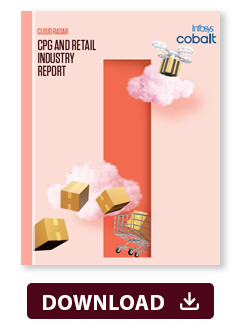
Executive summary
Cloud spending by consumer packaged goods (CPG) and retail sectors the world over is set to increase in 2024. Though CPG and retail companies are currently focused on strategic cost takeout – that is, making major changes to the business structure to reduce costs – given the current economic climate, their motives for migrating to cloud have had more to do with innovation and less to do with cutting costs, according to Infosys Knowledge Institute’s recent research.
The Cloud Radar 2023 surveyed more than 2,500 respondents from companies across nine industries – in the US, UK, Germany, France, Australia, and New Zealand, and the Nordic countries including Norway, Finland, Sweden, Denmark, and Iceland. The study surveyed 400 respondents from CPG and retail sectors.
The study found that CPG and retail companies depend on cloud for sophisticated solutions, growth, and transformation. They benefit from it – but they also face challenges when it comes to their cloud, in terms of usage and cost.
However, it is well within their abilities to overcome the issues provided they learn how to embed the right business case into cloud, master monitoring and prediction, and adopt a value-centric cloud operating model, among applying other best practices.
Cloud spending on the rise
While inflation growth is expected to slow down this year, the International Monetary Fund (IMF) predicts that a majority of countries could hit their target inflation rates only in 2025. Increasing revenue growth is one way for CPG and retail companies to bolster themselves against this situation and deal with other uncertainties such as geo-political crises, and natural disasters. It is no surprise that CPG and retail are relying on cloud adoption for revenue growth.
While a majority of CPG and retail companies began using cloud a decade ago, they continue to spend substantially on cloud. Each retail company surveyed in Cloud Radar 2023 said it spent around $29 million in 2022, and each CPG company said it spent around $31.4 million.
For both segments, the cloud spend increased from 2022, according to 65% of respondents in CPG and 67% respondents in retail, and is set to increase in 2024 as per 77% of respondents in CPG and 80% respondents in retail (Figure 1). This is possibly part of their efforts to increase cloud adoption so as to grow revenues to combat inflationary pressures, along with their need to scale their operations and become more agile in responding to business and customer demands.
Figure 1. The change in cloud spend from 2022 to 2023
Source: Infosys Knowledge Institute
Reasons for cloud adoption
Strategic cost takeout is another measure that companies have been aiming for, for the same reasons. It is important to note, however, that though CPG and retail companies are currently employing cost takeout, as per the Infosys study, their motives for migrating to cloud have had more to do with innovation and less to do with cutting costs.
CPG companies surveyed said their main motivation for cloud adoption was to enable a new revenue stream or product, followed by the need to access new technology or software development capabilities. Using cloud to reduce costs was a minor motivation.
The retail companies surveyed said much the same thing: Accessing new technology or software development and enabling a new revenue stream were their top reasons to migrate to cloud. Cost reduction was a minor reason for cloud migration.
Accessing new technology or software development and enabling a new revenue stream were the top reasons to migrate to cloud. Cost reduction was a minor reason for cloud migration.
Cloud being a digital transformation enabler, there are other reasons that CPG and retail businesses want to jump on the bandwagon. They are looking to achieve efficiencies across their IT and business systems and business agility in terms of responding quickly to customer behavior and market conditions. They want to create new spaces and capabilities to leapfrog competition. Cloud adoption gives businesses a chance to upgrade their existing systems, enhance industry-specific capabilities, and also connect with partners through collaborative tools. Cloud can help cut costs, and can help companies achieve their greenhouse gas emission goals by streamlining their operations.
Figure 2. Why companies move to cloud
Source: Infosys Knowledge Institute
Cloud is for digital commerce and CRM
Digging in deeper from general motivations, the study found that CPG and retail companies are most likely to use cloud for digital commerce and customer relationship management (CRM). They are less likely to use cloud for point-of-sale and in-store systems.
Customer relationship management
Businesses are using cloud to collect and store data related to customers’ past purchases, interests, and demographics, and use data analytics to better understand their buying behavior. This is helping them design personalized campaigns and target the customers using the most ideal channels, to up-sell and cross-sell.
These insights help them employ proximity marketing tactics, that is, provide highly targeted advertising and promotion content to consumers based on their current location. It is helping decide on store design and visual merchandising in a way that it drives traffic to the right products, displayed strategically to increase sales and revenue. It helps measure near real-time return on investment (ROI) on trade promotion, and redirect money from non-performing to performing promotions. It connects point-of-sale data with advertising spend to determine which locations to spend digital marketing on.
Cloud-native, microservices-based, API-first architecture with hyper-personalization capabilities and an integrated ecosystem are being used to deliver end-to-end digital commerce. The ability of cloud to help hyper-personalize customer journeys across physical and digital channels at scale is noteworthy. It helps retailers amplify their connection with customers and optimize spend by connecting the unconnected media data across sources such as search, social, CCTV, video and so on, along with assets such as images, video, or text, internal data, and syndicated data. Its what-you-see-is-what-you-get (WYSIWYG) interface and low-code-no-code capability helps users work with it easily.
Cloud-native omni-channel solutions allow for 3D visualization of assets. Retailers can use them for applications ranging from designing showrooms to allowing virtual try-on technologies on their e-commerce sites. Cloud-native AI-powered customer engagement platforms are being used in customer support. They extract data from customer interactions and transform them into insights that can be used in real time. They also help train agents in their customer interactions to drive better customer experience.
One of Infosys’s clients, a US-based retailer with a chain of specialty discount stores, was looking to expand its store operations across 10 additional markets. But it was being derailed by its inflexible legacy merchandising system that was unable to scale. Infosys used its Oracle Retail Merchandising Cloud Service to help the client transform its on-premises legacy system to a modern merchandising cloud platform that would support its business goals. Through this migration, Infosys helped the client cut the maintenance costs of their on-premises infrastructure. By introducing high levels of automation into processes, Infosys helped the retailer increase its operational efficacy while reducing the workload on its employees.
Cloud helps retailers amplify their connection with customers and optimize spend by connecting unconnected media data across sources.
Digital commerce
Online shoppers expect responsive online experiences and will move on if a website doesn’t meet their expectations: research by Akamai has found that 40% of visitors will abandon a website that takes longer than three seconds to load. Hosting an e-commerce website in the cloud means faster websites that can scale to meet demand, creating an experience that customers are more likely to return to.
Cloud should also offer a more secure environment for customer data than on-premises solutions, but retailers must ensure that they configure their cloud services correctly to avoid data breaches and take into consideration potential vulnerabilities that arise from connecting third-party technologies to their cloud systems. The data on cloud is also backed up across data centers which helps prevent loss of sensitive customer data and enables easy data recovery.
Infosys engineered an e-commerce site employing cloud and emerging technologies for a high-end fashion retailer that wanted an engaging and responsive e-commerce site to improve online sales. Infosys developed a native cloud solution by combining microservices architecture, AWS Infrastructure-as-a-Service (IaaS) and AWS Platform-as-a-Service (PaaS) with third-party solutions and open-source technologies. A mix of Agile development methodology, DevOps automation, and a decoupled microservices-based architecture reduced time-to-market to four weeks as opposed to the four to six months it would have usually taken.
The auto-scaling ability of the cloud environment helped manage peak loads and seasonal spikes in online traffic. These efforts not only helped in cost rationalization but also improved the website performance by 10 times.
Supply chain management
Cloud enables seamless access to enormous amounts of data and analytics platforms to deliver demand sensing. This capability helps retailers understand the shifting demand for products and forecast needs in an agile manner, which means they can optimize their inventory and mitigate problems arising from supply chain disruptions. It analyzes sales inventory patterns to identify root causes for phantom inventory. Having supply chain visibility and understanding demand well helps plan supply while ensuring lack of wastage of resources or excessive stocks, helping companies meet their business operations efficiency and sustainability goals.
The connectedness that cloud provides also enables quick product recall management from numerous sources, when the situation demands it, apart from providing traceability.
“CPG and retail businesses are implementing loyalty programs that are applicable across their brands, on the lines of a single pass that can be used to shop across,” says Shreshta Shyamsundar, distinguished technologist, Infosys. “This requires an optimal fulfillment and inventory management system throughout, so companies can make data-driven decisions and offer a great customer experience. These are some of the top business capabilities that companies rely on cloud for.”
“CPG and retail businesses are implementing loyalty programs that are applicable across their brands. This requires an optimal fulfillment and inventory management system throughout, so companies can make data-driven decisions and offer a great customer experience.”
– Shreshta Shyamsundar, distinguished technologist, Infosys
Technology innovations in areas such as data analytics and science, AI, and Internet of Things (IoT) are easily consumable through cloud, and are being used to maximize efficiency in the supply chain. “This includes smart factory solutions that help in real-time inventory tracking, equipment monitoring and diagnosing, robotic manufacturing and automation, digital twins for efficiency and safety, as well as predictive maintenance of equipment. Digital twin technology is also used to replicate supply chain workings in the cloud and ensure the supply chain runs smoothly. For example, Infosys helped a large confectionary manufacturer with a data and cloud-based solution to ensure the right level of inventory in stores and shelves in their large retail partner resulting in sustained business growth for them,” says Madhanraj Jeyapragasam, assistant vice-president and senior principal technology architect, cloud at Infosys.
“Digital twin technology is being used to replicate supply chain workings in the cloud and ensure that the supply chain runs smoothly. For example, Infosys helped a large confectionary manufacturer with a data and cloud-based solution to ensure the right level of inventory in stores and shelves in their large retail partner resulting in sustained business growth for them.”
– Madhanraj Jeyapragasam, assistant vice-president and senior principal technology architect, cloud at Infosys
Employee experience
The concept of live enterprises – that is, organizations that are agile, constantly adapting, innovating, and transforming to respond to business needs – is on the rise. To achieve this state, organizations are evolving their business using platforms designed to scale on cloud-native technologies and open-source software. Such cloud-based platforms are helping them enhance employee experiences, through the use of conversational AI, learning solutions, and implementing micro-change management to ensure adoption.
For example, Infosys helped a leading retailer to build applications to drive automation for its employees including an omnichannel chatbot offering personalized IT services to employees, a mobile app, voice bots to take over IT operation tasks, and so on. This was achieved using various cloud-based technologies built on AI, machine learning, RPA, and digital workflows.
In another case, a leading global CPG company was looking for its employees to manage queries and cases across functions with a unified enterprise tool. Its aim was to reduce the time employees were spending on simple tasks. The Infosys Cobalt cloud offerings were paired with ServiceNow platform to consolidate ticketing tools and replace the legacy version with a Single Query Management (SQM) tool. Features of the cloud-hosted solution streamlined processes, such as allowing for sharing support tickets, as well as building a self-service portal with an integrated chatbot to handle first-line support and triage inquiries to direct them to the right human.
Cloud -based platforms are helping organizations enhance employee experiences, through the use of conversational AI and learning solutions.
What cloud is good for
Deploying cloud services can not only bring about improvements and modernization of infrastructure and processes, it can also give businesses a competitive edge.
Scalability and agility
One of the biggest benefits of cloud is that it makes deploying a range of technologies such as AI, blockchain, machine learning (ML), and IoT much more straightforward compared to traditional platforms. CPG and retail companies have the option of ramping up their IT teams or decreasing resources easily as the needs of the business change.
“Festive seasons are a particularly busy time for CPG and retail functions, with a rise in traditional and organic demand. The ability to scale to demand during these occasions is one of the biggest benefits that cloud offers,” says Shreshta Shyamsundar. “In Western Europe, the roads are narrow, and the cities are congested, increasing the foot traffic in stores, whereas in North America and Australia, spaces are more spread out, and the expectation is that most consumers will shop online than in physical stores. This is a differentiator, and cloud is equally useful in both scenarios.”
He adds: “A leading supermarket chain in Australia segregates its stores based on the business they generate in a day. In stores with the highest business, the store manager has a direct line to call the IT department, and is empowered to make changes related to stocking inventory onto the shelves. The change is then individually deployed to the store. Cloud plays a significant role in centralizing the implementation logic, in terms of being able to manage preferences and make sure that the preferences are set universally. Some changes are maintained onsite but a majority that are required to remain agile is cloud-based.”
Easy access to data
Cloud brings together data from a multitude of sources and makes it available in real time for the businesses to access from anywhere. This provides a unified and complete view of the data which is particularly useful for businesses that require large storage capacity beyond that which on-premises servers can provide. A US-based leading CPG organization was using multiple applications, and was seeking an alternate hosting platform, to increase the time-to-market and agility. Infosys helped it transition operations to cloud infrastructure helping decrease operational costs by over 30%.
Cost savings
Moving to the cloud can also save money compared to maintaining on-premises infrastructure and the staff needed to manage it. Infosys has helped many clients save money by shifting to the cloud: “For a leading US food products company, we were able to reduce their spend to achieve an industry-leading 0.31 opex spend ratio with a high net promoter score (NPS) and key performance indicator (KPI) score. And then, for a leading British consumer goods company, Infosys was selected from 15 incumbent partners to drive efficiency and cost optimization. There we consolidated 14 data centers into four (data centers) and hybrid cloud achieving 3.3% opex spend, and elevating their NPS by over 75%,” explained Kathryn Bieler, an Infosys AVP for consumer, retail, and logistics during a webinar on strategic cost takeout. “For an American fashion retailer, we modernized their tech, moving them to a cloud solution through their app rationalization with over $100 million in cost-savings.”
A US-based leading CPG organization was using multiple applications, and was seeking an alternate hosting platform, to increase the time-to-market and agility. Infosys helped it transition operations to cloud infrastructure helping decrease operational costs by over 30%.
Emerging cloud challenges
As beneficial as cloud adoption is for CPG and retail companies, it is not devoid of challenges. Cloud works well and delivers on increasingly sophisticated tasks. But as cloud systems have advanced, additional complexities are emerging. Though cloud is fairly uncomplicated to implement, many businesses are finding it challenging to choose which cloud solutions to use – without proper guidance on the frameworks or recommended practices required to achieve maximum impact – or even where to use it. Some of the biggest challenges that plague CPG and retail companies are as follows.
Many businesses are finding it challenging to choose which cloud solutions to use – without proper guidance on the frameworks or recommended practices – or even where to use it.
Old versus new operating models
The rate of technology change in CPG and retail sectors is much faster than that of highly regulated sectors such as financial services or utilities. Hence, sometimes two or three operating models must co-exist in an organization, and that creates further challenges for businesses that need to run them at the same time. We found in this research that most of the CPG and retail respondents said that they were using four cloud providers at any given time, which presents a challenge of its own.
Integration with existing systems
Retail and CPG companies that have complex legacy systems find it is difficult for the systems to integrate with modern cloud-based systems, especially when the companies contain varied and non-standardized IT systems that have been functioning in isolation, each using different data formats. The larger the organization, the greater the number of disparate IT systems, making the integration more challenging.
Tug between business and enterprise IT
With the retail industry, much of automation technology is going into store and supply chain transformation. This is not owned by enterprise IT, but managed by the business teams directly. This leads to a lack of integrated solution and collaboration in terms of the use of cloud when cloud technology comes into the picture.
Lack of business use case
The Infosys study shows that organizations do not have an approved business use case to employ cloud adoption as often as they should, and this applies to CPG and retail companies: 34% of respondents in retail and 29% in CPG (Figure 3) disclosed that they have a business use case only somewhat and less. With any technology, lack of clarity – in terms of what it needs to be used for and the outcomes that define success – can be disastrous.
Figure 3. Approved business use cases for cloud across industries
Source: Infosys Knowledge Institute
Struggle to control, predict, monitor, and optimize spend
It goes without saying that keeping on top of cloud costs is vital: our research found that retail cloud managers are generally confident in their ability to run their systems – but they are least confident when it comes to monitoring, predicting, and optimizing cloud costs.
Figure 4. CPG and retail companies are struggling with cost management
Source: Infosys Knowledge Institute
More than half of the CPG and retail respondents struggle (Figure 4) to monitor costs. This lack of visibility into the cloud costs, possibly from a constantly changing market, makes it difficult for them to use their cloud spend effectively. It does not help that the cloud committed by the companies ends up being lesser than the cloud consumed at the end. In fact over 73% of respondents in CPG and retail (Figure 5) said they consume less than 50% of the cloud service that their companies have contracted.
Figure 5. Less than 50% of cloud services contracted are being consumed
Source: Infosys Knowledge Institute
Data security and privacy
Cloud can help businesses improve their security, but it brings its own risks. Research by Gartner finds that through 2024, most enterprises will continue to struggle with appropriately measuring cloud security risks. Retail and CPG companies deal with sensitive customer data, and data breaches can be costly for them in terms of both money and reputation.
A large number of respondents in both CPG and retail segments told us that migration to cloud creates new security challenges for them. One key risk is the security teams not having a clear view of cloud deployments in the business: we found, for example, that 41% of retail and CPG respondents allow any department head or IT manager to deploy new cloud infrastructure, software, or applications (Figure 6). That might be too lax from a security perspective, as it could increase the chances of human error, the leading cause of cloud data breach. But that must be balanced against the dynamic changing demands of business.
Figure 6. Access allowed to more individuals than necessary
Source: Infosys Knowledge Institute
Compliance and regulation
When new technologies come in, businesses are keen to use them to create value and efficiencies in processes or new products or services which create new market potential. But they have challenges such as adopting the technology along with the enterprise controls, governance, and compliance needing to be met. Additionally, retail and CPG companies must comply with data privacy, security, and consumer protection regulations, all of which differ depending on where those businesses are located. Any failure in complying with security protocols could mean an increased risk of data breach, not to mention hefty penalties by regulatory bodies.
Operational resilience and governance
Companies demand cloud systems that can recover faster from incidents ranging from human error to natural disaster with the least downtime, causing the least disruption to business. Deploying cloud is not just about integrating it with existing IT systems – businesses also need to create security protocols to prevent data loss or theft, as well as risk management policies. It also includes the aspect of which individuals get to make critical decisions related to the use of cloud in the organization.
Cloud today is a domain where business and IT must work together. Modern cloud requires both technical and strategic thinking. However, we found a lack of overarching strategic thinking: when we asked about a range of critical cloud decisions, 44% of the respondents said the decisions are made in isolation (Figure 7). Decisions about cloud need to involve leaders, technologists, and end-users.
Modern cloud requires both technical and strategic thinking. However, we found a lack of overarching strategic thinking in the CPG and retail companies surveyed.
Figure 7. A majority of critical cloud decisions are made in isolation
Source: Infosys Knowledge Institute
Surging through
While the list of challenges is long, adhering to best practices can help CPG and retail companies find their way to successful cloud adoption.
- Change management is required to help employees become willing participants in the transformation, and reskill them if required. Also, it is important to train people before the cloud capability comes in, so that by the time it arrives, most can start working with the new tools immediately. They will be able to play the old and new roles simultaneously, and the transition becomes much smoother.
- To overcome the challenge of integration, companies can work with cloud service providers to develop customized solutions that integrate with their existing systems. They can also consider migrating to cloud-native systems that are designed to work seamlessly with cloud-based solutions, or they can consider hybrid solutions to help make the transition. Preparation is also important: data transformation tools can help get data ready to move to the cloud, for example.
"Cloud is becoming the common platform to run enterprise IT workloads as well as business IT workloads across design, production, operations, and more. For the cloud platform services organization to work effectively, there needs to be a change – starting with defining common shared capabilities. It should also address the unique capability needs of enterprise IT and business IT with transparent funding and chargeback models,” says Madhanraj Jeyapragasam. - Cloud adoption must be aligned to the company’s business strategy and must have someone in the organization who is the business owner. The business must have a clear picture of value creation, and a realistic timeline in terms of growth. This also means that funding models will need to consider the return on investments in cloud. They must apply micro change management, and have a broad idea of measures but implement them incrementally with sustained investments. This requires executive management support and buy-in, and all stakeholders must be aligned to the broader objective and be aware of the incremental minimum viable products they need to achieve to move toward the target and keep the investments sustained.
- To overcome the challenge of cloud cost management, companies should master monitoring and prediction using cloud cost management tools and processes. Once they have created a business case around cloud investment and identified aspects such as who will be responsible for purchasing it, who will be paying for it, who will be using it, and so on, it creates clarity around the spend and monitoring of outcomes. They can also work with cloud service providers to develop customized solutions that meet their specific cost management needs.
- To overcome the challenge of data security, companies can leverage the expertise and resources of cloud service providers to enhance their data. Retail and CPG companies should particularly consider the risks presented by the specific technologies they use, such as beacons and point-of-sale terminals, and work with their cloud providers to ensure secure integration and management of those processes into the wider cloud platform.
- To overcome the challenges of compliance and regulation, companies can work with cloud service providers that have experience in and a reputation for complying with regulations. They must be thorough with government regulations and regulatory standards that are applicable in their countries as well as how they fit into international laws, and implement internal policies and procedures to ensure compliance with regulations.
- Operational resilience is a key consideration for any cloud deployment, and demands a robust recovery system as well as an effective monitoring system to scan for and respond to potential threats.
- Companies must have a comprehensive cloud governance strategy in place. They should establish clear protocols for ownership, procurement, oversight, and data management in the cloud. As governance and security go hand-in-hand, having a powerful governance helps bolster security.
A combination of these practices will help CPG and retail companies harness the potential of cloud, bring their businesses up to date and boost their growth. As the power of cloud continues to grow, adhering to these recommendations will become even more important for businesses to thrive.
Appendix: Research approach
Qualitative interviews
To enrich insights, we conducted phone interviews with more than 50 industry practitioners, executives, and subject matter experts.
Quantitative survey
Respondents by region
Source: Infosys Knowledge Institute
Respondents by industry
Source: Infosys Knowledge Institute
Quantifying unused cloud commitments
The unrealized revenue figure of $300 billion is based on the declarations made by cloud service providers in their latest 10-K (or 20-F filing in case of foreign listed companies) to the Securities and Exchange Commission (SEC). To arrive at the unrealized revenue value, we searched for the following declarations in the liability section of the SEC filings of the company’s balance sheet: "unearned revenue", "deferred revenue" or "backlog revenue". Most of the cloud provider companies have declared these values as a part of a short-term or long-term liability on their balance sheets depending upon the status of the contracts involved.
For the estimation, we recorded and then added the unrealized revenues for the cloud services providers covered in our study based on their SEC filings. We only included B2B unearned, deferred, or backlog revenue, and excluded any declared unrealized revenue listed as a liability due to B2C subscriptions or services. For example, Microsoft Xbox and other personal subscriptions was recorded under personal cloud subscription services was not included in our data analysis.
Our research indicates that this $300 billion represents 53% of currently contracted cloud services. From this we estimate that the total amount of currently contracted cloud services exceeds $600 billion. Companies and their providers estimate the remaining $300 billion in unused cloud commitments will be consumed in the next three to five years but will likely be renegotiated and blended into a larger figure for longer contract terms.
















